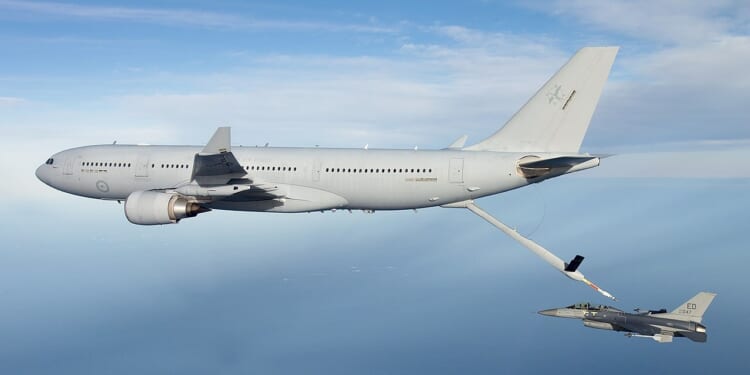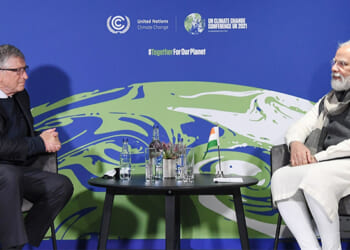Currently, European NATO members possess a fleet of 156 midair refuelers, compared to America’s fleet of 447.
Europe has made a commitment to restoring its indigenous defense capabilities. As it looks to the east, it sees a resurgent Russian bear—slashing hard against Ukraine and growling at the European members of NATO with increasing frequency and belligerence.
European rearmament is not just a matter of building more weapons and deploying platforms, like warplanes and tanks. One of the key capabilities that the Europeans will need to create for themselves in the arena of midair refuelers.
Understanding Airbus’ “MRTT” Aerial Refueling Project
The Airbus A330 Multi-Role Tanker Transport (MRTT) is a military aerial refueling and transport aircraft derived from the commercial A330-200 airliner. It is operated by the NATO Support and Procurement Agency (NSPA) as part of the Multinational MRTT Fleet (MMF) program, which pools resources from multiple NATO member nations to prove shared air-to-air refueling (AAR), strategic transport, and medical evacuation capabilities.
The MMF was initiated in 2016 by the European Defense Agency and is managed by NSPA on behalf of NATO, with the Organization for Joint Armament Cooperation (OCCAR) overseeing acquisition. Participating nations include Belgium, the Czech Republic, Denmark, Germany, Luxembourg, the Netherlands, Norway, and Sweden, with aircraft based primarily at Eindhoven Air Base in the Netherlands and Cologne Bonn Airport in Germany. The fleet achieved initial operational capability in 2023 and supports NATO missions by enhancing interoperability and reducing reliance on individual national assets.
The A330 MRTT is designed for versatility, featuring fly-by-wire flight controls, an under-wing hose-and-drogue refueling system, and an optional aerial refueling boom system (ARBS) for compatibility with various receiver aircraft. It can perform simultaneous refueling operations and switch roles between tanker and transport mid-mission.
The MRTT’s Specifications
- Year Introduced: 2011
- Number Built: 65
- Length: 58.8 m (193 ft)
- Wingspan: 60.3 m (198 ft)
- Weight (MTOW): 233,146 kg (514,000 lb)
- Engines: Two turbofan engines with options for either the Rolls-Royce Trent 772B, General Electric CF6-80E1A4B, or Pratt & Whitney PW4170, each producing up to 72,000 pounds of thrust
- Top Speed: 880 km/h (475 knots, 547 mph)
- Combat Radius: 1,800 km (972 nmi) with 50 tonnes of fuel for 4 hours
- Service Ceiling: 13,000 m (42,700 ft)
- Loadout: Advanced 2D/3D digital refueling monitoring; enhanced vision systems; defensive aids (such as J-Music DIRCM for missile protection in MMF variants); compatibility with boom, probe-and-drogue, or under-wing pods for refueling
- Aircrew: 3
Europe’s Lack of Adequate Refuelers Is a Big Problem
This bird is one of the most capable modern tankers, with proven combat operations in 13 nations and over 250,000 flight hours globally. Yet the Europeans lack enough of these planes for sustaining the kind of air combat operations they would need to sustain if Europe chose to expand its conflict with Russia over Ukraine—or if Russia really did choose to go beyond Ukraine and attack NATO.
Currently, Europe possesses a fleet of 156 midair refuelers, according to CSIS—compared to a fleet of 447 in the United States. The Europeans have considerable gaps in their capabilities that have little chance of being plugged at least until the start of the next decade.
Ultimately, if war with Russia were to break out today and America decided to sit on the sidelines, that fleet of European midair refuelers would be wholly insufficient to fill in for the US tanker fleet, if that fleet was suddenly unavailable or only available in a limited way.
While the A330 MRTT is more advanced in some respects—such as greater fuel offload capacity per aircraft—it lacks the volume to fully substitute for US assets. In fact, it only represents about 10 percent of the US primary tanker count. The lack of aerial refuelers is a microcosm of Europe’s other defense shortcomings. Put simply, there is no way the European members of NATO are ready to wage war against Russia—let alone to win.
About the Author: Brandon J. Weichert
Brandon J. Weichert is a senior national security editor at The National Interest. Recently, Weichert became the host of The National Security Hour on America Outloud News and iHeartRadio, where he discusses national security policy every Wednesday at 8pm Eastern. He is also a contributor at Popular Mechanics and has consulted regularly with various government institutions and private organizations on geopolitical issues. Weichert’s writings have appeared in multiple publications, including The Washington Times, National Review, The American Spectator, MSN, The Asia Times, and others. His books include Winning Space: How America Remains a Superpower, Biohacked: China’s Race to Control Life, and The Shadow War: Iran’s Quest for Supremacy. His newest book, A Disaster of Our Own Making: How the West Lost Ukraine is available for purchase wherever books are sold. He can be followed via Twitter @WeTheBrandon.
Image: Wikimedia Commons.


















